I’ve been a victim of losing stunning houseplants due to improper watering techniques. I stumbled upon self-watering pots that were indeed a savior. I wrote this article to share with you some of the exciting things about these planters.
So, how do self-watering pots work? It is through wicking or capillary action. Self-watering planters have a growing bed, potting mix, and water reservoir linked to a wicking system that puts soil into contact with water.
The roots absorb water from the soil as the wicking system pulls up more to enhance consistent soil moisture. These self-watering pots save the plant owner from the hustle of keeping track of soil moisture before watering.
Keep reading for more insights on how self-watering planters work. You’ll get to know the reasons behind their rapid growth in demand. The information also offers inspiration for trying these innovative pots.
You May Also Like: Do Philodendrons Like to Be Misted?

Do Self-Watering Pots Actually Work?
Yes. Self-watering planters make growing houseplants look easier regardless of individual skills and experience. These planters enhance convenience, water efficiency and improve plant health.
Self-watering pots rely on a wicking system and water reservoir to maintain consistent soil moisture. The capillary action helps to replace water absorbed by roots by allowing the soil to wick more from the storage.
The mechanism relies on intermolecular forces in the liquids and attraction forces between a material surface and liquid molecules. These cohesion and adhesion forces make capillary action successful.
Self-watering pots water the houseplant from the topsoil according to its requirement. As the plant losses water via the leaves, it wicks more from the roots. The capillary action also helps to replace water lost from the roots and soil from the reservoir.
If you’ve proper potting mix and wick mechanism, the soil will remain moist throughout. These planters are suitable for houseplant enthusiasts planning for a short vacation. Keep in mind that the potting soil will never become soggy or damp.
How to Set up Self-Watering Pots?
Setting up a self-watering planter is a no-brainer task. It’s inexpensive since you can use readily available materials.
But if you’re not a DIY guy, there are several online plant stores to purchase ready-made planters. Below are steps on how to set up self-watering planters:
Step 1: Sub-Irrigation Insert and Aeration Stones
Put the sub-irrigation insert in the planter. Ensure the equipment sits evenly and pour aeration over it until it is fully covered.
Step 2: Transplant the Plant into the Pot
Remove the houseplant from the existing pot with ultimate care. Do not remove the soil around the plant roots. Place it into the self-watering planter.
Step 3: Fill up with Soil
Fill the planter with soil and compact it to secure the plant. Water the houseplant according to their requirements and set the self-watering pot on the sauce reservoir.
You Can Also Read: How to Keep Moss Pole Moist
Pros and Cons of Self-Watering Pots
Self-watering pots come with some advantages and disadvantages. Trying these innovative planters will help you make an informed decision in the long run.
Pros of Self-Watering Pots
Enhance Consistent Soil Moisture
Self-watering planters ensure there is consistent soil moisture around the plant effortless. The pot removes any watering guesswork and minimizes the risks associated with inconsistent watering habits.
Efficient Water Use
The water reservoir helps to reduce the evaporation rate. It allows the plant roots to utilize the available water to the fullest. It also minimizes water wastage, as seen when spraying it directly on plants.
Improve Plant Health
Most houseplants are more vulnerable to overwatering and under-watering issues. These improper watering habits may harm your favorite plant. Self-watering pots ensure water comes from below to protect the leaves from diseases.
Different Types and Styles
Self-watering comes in different types and styles. Each design is known to suit specific houseplants. The varieties of options allow the plant owner to make a perfect choice.
Go for Vacations
Self-watering planters keep the houseplants well-watered and thriving. It will enable a plant owner to go for a vacation without worrying about their favorite plant. Be sure the reservoir has adequate water.
Cons of Self-Watering Pots
Limited to Some Plants
The role of a self-watering pot is to ensure consistent soil moisture content. But some plants thrive in dryer conditions. Drought-tolerant plants may not benefit from self-watering planters.
Not Ideal for Rainy Climate
Self-watering pots can become waterlogged when applied in areas with excessive rain. The damp environment facilitates the emergency of root rot. The root disease will inhibit capillary action and cause the plant to die.
Causes Salt Buildup
Self-watering pots force the plant owner to use liquid fertilizer in the reservoir. The practice results in a salt buildup in the water storage and soil. Over-fertilization usually causes plant leaves to turn brown and crispy.
You Can Also Read: How to Make Homemade Fertilizers for Indoor Plants
Basic Features of Self-Watering Pots
DIY and readymade self-watering planters should have the following vital components. These features allow the pot to carry out its function appropriately.
Planting Container
It is the top section of the planter where the plant grows in the potting soil. The section contains aeration stones and soil that hold up the plant while growing.
Potting Soil
Self-watering pots do not need regular garden soil. The soil is too heavy and dense to cause more harm to the plant. Use a lightweight potting mix to avoid compaction in the future.
Water Reservoir
Water storage comes in different sizes depending on the weather. But it is usually proportional to the overall planter. Always replenish the reservoir when water is low.
Wicking System
The capillary action delivers water from the reservoir to the soil and onto the plant roots. The mechanism ensures the potting mix is directly in contact with water from the reservoir.
Related Questions
Are Self-Watering Pots Good for Indoor Plants?
Yes. Self-watering planters are suitable for most indoor plants. These tropical plants need a consistent soil moisture supply. These planters make the task look easier.
Do Self-Watering Planters Cause Root Rot?
Yes. Constant moisture increases the risk of root rot. It is one of the reasons why self-watering containers are not suitable for some indoor plants.
How Long Do Self-Watering Pots Last?
Approximately 2-3 years depending on the quality of the material. But it is advisable to re-pot indoor plants every 2-3 years to avoid root-bound issues. Always use a new and sterilized self-watering container.
Do Self-Watering Planters Attract Mosquitoes?
Yes. Stagnant water in the reservoir will naturally attract mosquitoes. Adding a few drops of oil will help to inhibit the mosquitoes from breeding in the reservoir.
You May Also Enjoy: Black Spots on Houseplant Leaves

In Conclusion
Self-watering containers work when they are used appropriately. The planter uses capillary action to draw water from the reservoir to the soil and plant roots. The wicking system relies on the cohesion and adhesion forces to be successful.
The most exciting thing is that self-watering pots’ advantages usually outweigh their disadvantages. Choose a planter that will suit your indoor plant to enjoy the benefits associated with it.
If you are going for a vacation, consider self-watering pots. There are several types of planters in the market today. Consider durable materials with a better water storage system. Keep in mind that water in the reservoir can last for 3-4 weeks.

